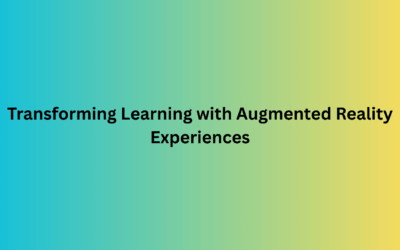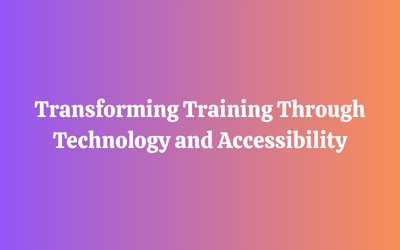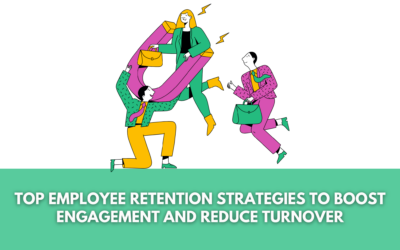How is learning agility carried out?
The ability to retain information from encounters and apply it to novel conditions is known as learning agility. It is essential to be able to come up with effective behaviors and change the situation.
Speed and adaptability are two essential aspects of learning agility. Employees who are quick and adaptable can act quickly and are open to new concepts.
Learning agility is the most effective strategy for safeguarding your staff against unforeseen circumstances that could prevent them from achieving business objectives. Thus, your staff individuals should constantly learn, forget, and relearn. They need to have meta-skills, problem-solving abilities, and high-order thinking to survive in the post-COVID era and deal with the disruption caused by digital acceleration.
Why is it important to learn to be agile?
Since it has a significant impact on performance, several businesses are incorporating agile learning into their learning strategy.
After adopting an Agile approach, sixty percent of businesses see an increase in profits.
Risks and difficulties are not feared by agile learners. They are at ease in stressful situations. Employees who practice learning agility are more likely to take on new challenges, solicit feedback, reflect on their flaws, and strive for growth and improvement. The employee’s and the business’s success are both benefited by learning agility.
After COVID, uncertainty has become the new normal, and strategies that were successful in the past now lead to stagnation. In a VUCA (volatile, uncertain, complex, ambiguous) world, only employees who are flexible, innovative, and resilient can achieve success.
The team and the leaders need to learn to be agile. Change management may be difficult for leaders who have not followed the learning agility path. They might not have noticed the change at all; this could influence both the pioneer and the group’s exhibition. Therefore, it is critical to cultivate a learning agility culture for both the leader and the team so that they can learn from their mistakes and overcome obstacles.
6 steps for putting an agile learning process
Into action Agile learning is a positive approach that encourages employees to view challenges as opportunities rather than threats and issues. However, to establish an agile learning environment that makes it much easier for your employees to acquire new skills,
The following six steps should be taken when implementing an agile learning process:
- Before beginning the agile learning process, establish clear goals and objectives.
- Identify and benchmark the skills required to be fully agile.
- Create agile learning programs by curating content and designing learning modules that are in line with the company’s objectives and required skills.
- Executive buy-in: Help employees comprehend the advantages of full agility and the implications for their careers.
- To learn to be fully agile and increase collaborative productivity, encourage communication within the team by moving beyond silos.
- Survey and reconsider – Track the spry growing experience and roll out convenient improvements to guarantee the light-footed learning approach is effective.
Learning Ability vs Learning Agility
Is necessary to avoid underestimating agility. Where the former ends, the latter begins. You reach a specific point as a result of your ability. After that, agility becomes crucial.
Learning agility is behavioral and related to your emotional intelligence, whereas learning ability is more based on your IQ. Learning agility can be developed and improved, whereas learning ability can be hard-wired.
Ability can be taught, but agility cannot be. Agility can only be instilled and developed through ongoing education and training, as well as an awareness of and involvement with the environment.
The publishing identifies 2 essential components of learning agility.
To succeed in volatile times, organizations require leaders with learning agility. Is it possible to teach someone to learn more quickly?
They say yes and have identified a few important aspects that could improve someone’s learning agility. These abilities are fundamental to effectively lead organizations in the present VUCA working climate, and contain 2 parts:
1. Possibility to Learn
The skills that make you successful in a particular job today might not be enough for tomorrow. A person who is learning agile has a mindset that is open and receptive to constantly experiencing new things to achieve new goals.
2. Motivation to Learn
Because it is hard work to change ingrained behaviors and long-standing habits, learners need to be engaged in and inspired by the learning process for learning to take hold.
5 vital variables of learning nimbleness
1. Mental agility
Is more comparable to street smart than to book smart. The best example is the best salespeople who can capitalize on a product’s unique selling propositions. With the power of their words, they force you to swipe the card. Such representatives are interested, and they continually investigate new methodologies and procedures to succeed in their selling game. Mentally agile workers accept complexity, remain curious, and make new connections.
2. Individuals’ spryness
Individuals’ spryness comprises attributes like correspondence, relational, and initiative abilities. These workers can bring out the best in others and have a high level of emotional intelligence. As a result, they are frequently approached during times of crisis. Employees with strong leadership qualities, for instance, are adept at navigating challenging circumstances. During stress tests or mock calls, team members frequently prefer them. People with individual deftness are helpful toward others and can flawlessly manage struggle. They work well together and can learn from a variety of points of view.
3. Result agility
A person can consistently deliver in unfamiliar or challenging circumstances. They are frequently composed and calm. These workers never give up and work hard to achieve their objectives, even in unfamiliar circumstances. For example, the best SEO professionals try to keep up with Google’s constantly changing algorithms and look into different ways to make sure the website ranks well. Even if they observe a decrease in website traffic, they do not panic. Instead, to boost the website’s ranking and traffic, they experiment and work together with other teams like the content writers and marketing team.
To meet a variety of challenges, these professionals constantly expand their knowledge.
4. Change agility
Change agility is a very similar concept. Change-agility individuals are experimental and do not hesitate to take uncharted paths to solve a problem. They don’t worry about failing; These employees keep trying until they succeed and gain knowledge from their experiences. The highest-performing executives in customer success who do not give up despite not receiving referrals are the best illustration of change agility. They alter their strategy and try again to obtain high-quality referrals from satisfied customers.
Change-agility individuals are always eager to learn new things. They coordinate learning into the progression of work to handily address any obstacle that comes in their direction
5. Self-awareness
Employees with high self-awareness scores are aware of their limitations, strengths, and weaknesses. They use feedback to improve and perform at their best. Employees who are aware of the potential for improvement are the best illustration. They frequently record their objectives and conduct objective assessments to monitor their progress.
Employees with low learning agility and those with high learning agility can perform at a significantly different level. How?
Now, let’s see how employees with low learning agility stack up against employees with high learning agility:
- Employees who lack learning agility are reluctant to step outside of their comfort zone and take on new responsibilities. Employees with high learning agility, on the other hand, quickly and confidently acquire expertise in completing new tasks.
- Because they blindly follow instructions, employees with low learning agility do not contribute value. Employees with high learning agility are always adding value because they take initiative, experiment, and innovate.
- Change and challenges are not appealing to employees with low learning agility. Employees with high learning agility, on the other hand, always put their best foot forward when faced with challenges or changes. They spend time improving themselves so that they can reach their full potential. Workers who lack learning agility are limited to current business requirements.
- Employees with high learning agility, on the other hand, anticipate future requirements and consequently acquire new skills to remain job-ready at all times.
- Employees with low learning agility struggle to adapt to new procedures and take longer to complete tasks. To complete more work in a shorter amount of time, employees with high learning agility embrace the most recent tools and upgraded skills.
- Employees with low learning agility require supervision, whereas those with high learning agility can continuously monitor their work and close the performance gap.
Aspects of learning agility
You must take into account the following aspects of learning agility if you want to be an agile learner:
Challenging the status quo
It is essential to challenge the status quo and discover novel and creative methods of action. The majority of employees are afraid to challenge long-held assumptions because they feel constrained by their position within the organization. It is necessary to alter this stereotype.
That requires new experiences and expanding one’s understanding and knowledge base. People with high learning agility can see things from multiple points of view, which helps them come up with new ideas. They voice their opinions and ask questions until they are completely in agreement with a viewpoint.
Experiences can be used as a learning tool
Overcoming an unfamiliar obstacle is an experience. It is essential to remain calm, focused, and engaged to learn from such difficulties. In addition, to perform better, one must effectively manage the stress that comes with such uncertainties and adapt quickly. In this case, keen observation, listening skills, and the capacity to quickly process data are of the utmost importance. By doing so, it makes it easier for people with high learning agility to quickly pick up new skills and perform better than their less agile peers.
However, just having new experiences does not guarantee that one will gain knowledge from them. To gain a better understanding of one’s assumptions and behavior, it is essential to solicit feedback and focus on processing information.
Exploring uncharted territory
The next essential part of developing agility is exploring uncharted territory and putting oneself in an unfamiliar setting to experiment with new activities. Agile students are curious, daring, and accustomed to taking on more and more risks. They are not just thrill seekers; they also welcome risks that lead to opportunities.
They don’t hesitate to volunteer for jobs and roles where failure is possible and success is not always guaranteed. Learning-lithe people never botch an open door to learn, and they store up certainty by extending themselves outside their usual range of familiarity, bringing about a pattern of interminable achievement.
Characteristics that enhance the entire agile learning process The following characteristics are necessary for the success of any agile learning initiative:
Determination
It is not easy to implement an agile strategy. It requires employees and leaders to be unwaveringly determined.
Due to the L&D’s need to regularly review and revise courses, the transition to agile learning can be challenging. For instance, a leader in L&D may send prospecting emails, make a cold call, and create a playbook on strategies and techniques for the pre-sales team but not update it. In the field of sales, tactics, and strategies are constantly evolving. Therefore, L&D leaders must continuously update the playbook with unwavering determination and take immediate action. It is essential to view failure in a positive light rather than giving up on the objective of establishing an agile process. Even employees need to be determined to complete the courses and evaluate their performance to improve at their jobs.
The framework can produce beneficial outcomes once it is successfully established. Therefore, for a smooth transition to an agile learning culture, it is essential to establish solid foundations and gain executive support.
Maintain order Keeping things in order makes the transition to learning agility simple. By setting goals, defining principles, planning the process, and measuring the impact, the agile learning process must be streamlined.
Ensures that the executive and leaders follow the agile learning principles meticulously. Learning is more likely to be successful for agile students who are well-organized and able to quickly adjust to new situations.
Commitment to continuous learning
To implement agile learning on a large scale, a genuine commitment to continuous learning is required. In agile learning, it is essential to examine, identify, and attempt to overcome obstacles.
L&D professionals frequently overlook the significance of ongoing education, which results in unsatisfactory outcomes. A company cannot become agile overnight. It must be handled incrementally, with just-in-time learning and timely changes at appropriate intervals. To improve the agile development process as a whole, it is essential to maintain transparency and have discussions about what went wrong and where the team needs to go the extra mile.
How can leadership qualities be enhanced by cultivating agile learning?
Agile leaders are very open to new ideas. To keep up with the ever-evolving business environment, they are enthusiastic about reviving processes and changing how things work. Agile leaders learn, listen, and then act, as opposed to acting rashly and impulsively. Consequently, it is urgent to foster nimble initiative characteristics and abilities to turn rapidly and manage incessant interruptions.
Initiative abilities are changing at a high speed. Learning agility facilitates the development of these skills in real time and demonstrates novel behavior to quickly move the team in the right direction. Pioneers with the right abilities can adjust to complex circumstances and guide their groups to work in new ways. The leaders can facilitate change, empower the team, and make a difference with their stellar performance with the assistance of learning agility.
7 best practices for effective agile learning
A flexible and receptive mindset is necessary for learning. In today’s VUCA world, anyone can become an agile learner and succeed.
The best practices for creating an environment conducive to learning agility are listed below.
1. Utilize assessments to measure learning agility
When focusing on employee learning and development, learning agility is a crucial metric. When determining an employee’s level of learning agility, businesses can take into account any of the five learning agility factors. You can assess an individual’s personality traits, abilities, emotional intelligence, and behavioral style using that as a foundation to determine their level of learning agility.
2. Develop meta-skills to deal with uncertainty
A meta-skill is a high-order skill that speeds up learning and skill development. Your employees will have an easier time navigating uncertainty if they have mastered meta-skills. Given that we are in a time of change, it is necessary to establish a culture of ongoing education. An agile learner tries to develop meta-skills through self-paced or microlearning to develop a comprehensive set of capabilities that can be used in unforeseen situations.
3. Learn from colleagues through social learning by working together.
A high level of learning agility is made possible by working together. Collaboration speeds up the resolution of unexpected issues. You can welcome every one of your representatives on one stage to conceptualize and address unsure circumstances through friendly learning. For example, Stratbeans provides a social learning platform similar to Buzz where all employees can ask questions, talk about new strategies, and figure out how to deal with various problems.
4. Make preparations open
You can’t anticipate that students should be lithe by offering just face-to-face educator drove preparing. Employees require constant access to learning resources and full control over their skill development.
With a man-made intelligence-fueled LXP, you can make a consistent computerized opportunity for growth where representatives can get to learning modules at any hour of the day. In addition, it permits the integration of interest-based learning and in-person instruction. Based on the job role, interests, and learning preferences of the employees, the AI in LXP makes intelligent and personalized learning recommendations. With Stratbeans LXP, you can provide your employees with the freedom to explore skills that interest them while simultaneously driving learning initiatives that seamlessly integrate with their workflow.
5. Open the door to communication through feedback in both directions.
Learning agility culture implementation can succeed if learners and L&D professionals work together. Make criticism a two-way road where representatives get input on their learning progress, and L&D can get input on the learning modules they’ve planned.
If the learning agility approach is to be successful, it is essential to thoroughly investigate analytics. In unfamiliar circumstances, are the executives putting their best foot forward and taking responsibility? Are the leaders able to anticipate potential turns and take immediate action? You can answer these questions and provide data-based feedback to close performance gaps with the right analytics.
6. Facilitate social learning Peer interactions can pass on a lot of useful information.
Therefore, establishing a social platform is essential for fostering an environment where employees can learn from one another and improve learning agility.
Employees from various teams can benefit from social learning that not only helps them retain knowledge but also helps them build professional networks. Employees can share useful resources and come up with fresh concepts to confidently address various challenges.
7. Learn how learning agility affects the evaluation process.
Agile students are strategic thinkers who are willing to try new things and take risks. These characteristics influence the performance review and attract attention during the evaluation process.
If given the right instructions, the agile learner is not afraid to take on new projects and investigate new areas outside of what they are already familiar with in their current job roles.
Subsequently, it is urgent to give workers a reasonable image of the significance of learning dexterity and what it can mean for their examination cycle to propel them to be more coordinated in their learning approach.
Utilize a platform for continuous learning to take advantage of learning agility.
Traditional L&D procedures do not take advantage of learning agility. At this point, organizations require a comprehensive continuous learning and dynamic performance tracking mechanism that measures both the tangible and intangible values that an employee brings to the team. This is necessary because millennials are taking over and the workplace environment is constantly changing.
On the other hand, if you want to contribute to the adaptability of your company, you need to keep in mind that your job is to not only train people but also to implement programs and strategies that foster an environment of continuous learning.
The time has come to combine work and education. They are the same thing. Incorporating learning into daily work is one of the characteristics of a learning agile organization.
In the present times, the significant contrast between fruitful individuals and those whose vocations waver is their capacity to make importance from their encounters. That incorporates grasping the settled in examples of conduct and perceiving the fine subtleties in various circumstances. These are the mental attributes you could helpfully connect with somebody who is learning nimble and shows the readiness and capacity to advance all through their professions, if not their whole lives.
Conclusion
Learning deftness assists your group with profiting from each open door that comes in their direction. It enables them to acquire the abilities necessary for survival in the volatile, uncertain, and unpredictable business environment of today. Learning agility, when combined with the right learning solution, can help empower your employees to overcome any obstacle. Check out Stratbeans, an all-in-one skilling suite, to see how it can help your employees become ready for the future.
Learn More
Our News
- AI
- Animations
- Articulate
- Articulate 360
- Articulate Engage
- Articulate Live
- Articulate Presenter
- Articulate Quizmaker
- Articulate Replay
- Articulate Review
- Articulate Storyline
- Articulate Storyline 3
- Articulate Studio
- bite sized learning
- Characters
- Content Library
- Corporate Communication
- E-Learning
- e-Learning Authoring Tools
- Employee Engagement
- Game-Based Learning
- Gamification
- Gamiflexer
- Go Sales
- Healthcare
- Instructional Design
- Interactivity
- Knowledge Transfer
- L&D Trends
- Learning
- Learning & Development
- Learning Experience platform
- Learning Management System
- LMS
- LXP
- Microlearning
- mLearning
- Mobile Learning
- Nugget Learning
- Online Training
- Peek
- Performance Support
- Preso
- Quiz and Assessment Platform
- Replay 360
- Rise
- SCORM
- Screen Capture
- Software
- Storyline 360
- Studio 360
- Training Management
- Trainings
- Uncategorized




